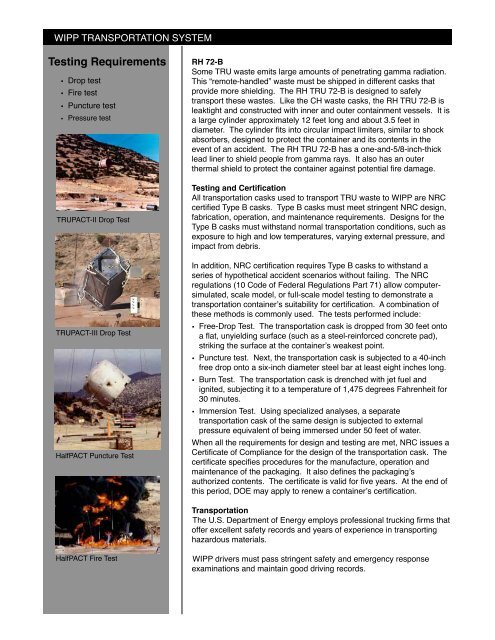WIPP Transportation System - Waste Isolation Pilot Plant - U.S. ...
WIPP Transportation System - Waste Isolation Pilot Plant - U.S. ...
WIPP Transportation System - Waste Isolation Pilot Plant - U.S. ...
You also want an ePaper? Increase the reach of your titles
YUMPU automatically turns print PDFs into web optimized ePapers that Google loves.
!<br />
<strong>WIPP</strong> TRANSPORTATION SYSTEM<br />
Testing Requirements<br />
• Drop test<br />
• Fire test<br />
• Puncture test<br />
• Pressure test<br />
TRUPACT-II Drop Test<br />
TRUPACT-III Drop Test<br />
HalfPACT Puncture Test<br />
HalfPACT Fire Test<br />
RH 72-B<br />
Some TRU waste emits large amounts of penetrating gamma radiation.<br />
This “remote-handled” waste must be shipped in different casks that<br />
provide more shielding. The RH TRU 72-B is designed to safely<br />
transport these wastes. Like the CH waste casks, the RH TRU 72-B is<br />
leaktight and constructed with inner and outer containment vessels. It is<br />
a large cylinder approximately 12 feet long and about 3.5 feet in<br />
diameter. The cylinder fits into circular impact limiters, similar to shock<br />
absorbers, designed to protect the container and its contents in the<br />
event of an accident. The RH TRU 72-B has a one-and-5/8-inch-thick<br />
lead liner to shield people from gamma rays. It also has an outer<br />
thermal shield to protect the container against potential fire damage.<br />
Testing and Certification<br />
All transportation casks used to transport TRU waste to <strong>WIPP</strong> are NRC<br />
certified Type B casks. Type B casks must meet stringent NRC design,<br />
fabrication, operation, and maintenance requirements. Designs for the<br />
Type B casks must withstand normal transportation conditions, such as<br />
exposure to high and low temperatures, varying external pressure, and<br />
impact from debris.<br />
In addition, NRC certification requires Type B casks to withstand a<br />
series of hypothetical accident scenarios without failing. The NRC<br />
regulations (10 Code of Federal Regulations Part 71) allow computersimulated,<br />
scale model, or full-scale model testing to demonstrate a<br />
transportation container!s suitability for certification. A combination of<br />
these methods is commonly used. The tests performed include:<br />
• Free-Drop Test. The transportation cask is dropped from 30 feet onto<br />
a flat, unyielding surface (such as a steel-reinforced concrete pad),<br />
striking the surface at the container!s weakest point.<br />
• Puncture test. Next, the transportation cask is subjected to a 40-inch<br />
free drop onto a six-inch diameter steel bar at least eight inches long.<br />
• Burn Test. The transportation cask is drenched with jet fuel and<br />
ignited, subjecting it to a temperature of 1,475 degrees Fahrenheit for<br />
30 minutes.<br />
• Immersion Test. Using specialized analyses, a separate<br />
transportation cask of the same design is subjected to external<br />
pressure equivalent of being immersed under 50 feet of water.<br />
When all the requirements for design and testing are met, NRC issues a<br />
Certificate of Compliance for the design of the transportation cask. The<br />
certificate specifies procedures for the manufacture, operation and<br />
maintenance of the packaging. It also defines the packaging!s<br />
authorized contents. The certificate is valid for five years. At the end of<br />
this period, DOE may apply to renew a container!s certification.<br />
<strong>Transportation</strong><br />
The U.S. Department of Energy employs professional trucking firms that<br />
offer excellent safety records and years of experience in transporting<br />
hazardous materials.<br />
<strong>WIPP</strong> drivers must pass stringent safety and emergency response<br />
examinations and maintain good driving records.

















